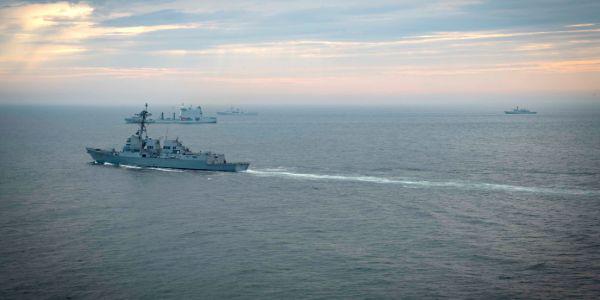Joint Force Command Strives to Maintain a Peaceful Atlantic
The U.S. Navy is adapting its Atlantic forces to interoperate better with those of its NATO allies while also incorporating navies from non-alliance countries. This approach includes incorporating a more expeditionary nature into U.S. forces while also extending the areas NATO and non-NATO forces operate to confront a growing multidomain threat from Russia. Traditional North Atlantic naval activities now extend into the Arctic Ocean, where changing conditions have opened up new threat windows.
The environment continues to grow more challenging and complex, particularly in the North Atlantic, says Vice Adm. Andrew L. Lewis, USN, commander, U.S. Second Fleet and commander, NATO Joint Force Command Norfolk. From the seabed to space, cyber is a major part of multidomain operations in the Atlantic region, he adds.
Adm. Lewis describes the Second Fleet and Joint Force Command Norfolk as a “unique animal” that is unlike anything before it. The Second Fleet was disestablished in 2011 and re-established in 2018, and it now is totally different from its previous incarnation. It is a fit for the time and purpose, the admiral says, adding that it is very lean compared to the earlier version. The current lean design is expeditionary and tailored to today’s Russian threat as opposed to the past Cold War confrontation. Its agility runs across the spectrum of operations from peacetime to conflict, he emphasizes, and this operational agility drives innovation.
With Joint Force Command Norfolk being an operational command at the operational level, the Second Fleet is actually a high-end tactical command, he points out.
The biggest challenge facing his command is “filling the seam in the Atlantic,” he says. This seam, which the admiral describes as physical, is the mid-Atlantic region. Meeting this threat-based challenge entails having awareness and being able to coordinate, interoperate, integrate and interchange with other forces in the region. Turning this seam from a vulnerability to an opportunity will impose a cost or operational dilemma on an adversary in that geographic space, he offers.
Adm. Lewis points out that Second Fleet forces are persistently present in the Arctic and throughout the Atlantic, which he describes as “a battlespace that cannot be ignored. The United States is an Arctic nation, and the region is integral to our national security,” he says. “We continue to manage that emerging domain with other Arctic nations in a way that is reciprocal, fair, peaceful and conflict-free.”
All but one of the Arctic nations are committed to a free, cooperative zone of operation, he states. “If we do not consistently operate in the Arctic with a measured and deliberate approach, the area is destined for conflict,” he declares. “U.S. and allied presence now, both naval and economic, in the Arctic could mean a peaceful, cooperative, flourishing environment.”
The Arctic is changing, with more navigable waters throughout the year, but it remains a very hostile environment, the admiral says. “It’s very hostile logistically; it’s very hostile from a standpoint of hazards to maritime navigation, and it’s increasingly hostile by virtue of aggressive actors who are trying to control things outside of the rule of law and international norms.”
The fleet’s presence in the Arctic entails a building-block approach, he continues. It has been conducting exercises with partners from among other Arctic nations. These may be small-scale exercises, but many of these nations have more Arctic operational experience than their U.S. Navy counterparts, he allows.
The increased emphasis on the Arctic also reflects a renewed threat from the Russian navy. Adm. Lewis states that the areas where the Russians are building up force constitute where they see vulnerabilities in the United States and the broader alliance. Seams and perceived weaknesses are exploited in hybrid warfare, where they can freely operate in the information realm wielding half-truths and lies. Their proficiency in cyber works well with other traditional strengths. In the undersea domain, Russia has continued its prominence in submarines and other capabilities there.
Adm. Lewis relates that his command recently conducted a “fourth battle of the Atlantic” tabletop exercise in Norfolk. The Joint Forces Command ran the exercise with the Second Fleet. By way of description, the first battle was World War I, the second battle was World War II, and the third battle was the Cold War confrontation with the Soviet Union. In the fourth battle exercise, the entirety of NATO was represented along with preferred partners such as Sweden and Finland.
The fourth battle of the Atlantic may already be underway. “We’re in it,” the admiral says. “It’s not just multidomain; it’s all domains, including cyber.” Some of the actions going on undersea are “nefarious if not downright aggressive,” he adds. “It’s a real threat.”
The admiral adds that the Russians are very observant about what is taking place with China, Iran and North Korea as well as violent extremists. They are opportunistic and will take advantage of opportunities—“if we allow them to,” he offers.
“We kind of fooled ourselves a few years ago at the end of the Cold War that the great power competition was dead or was no longer an issue,” he says. “But we’ve had an awakening … and that awakening continues.
“There is a real sense of urgency that we have to take on ourselves,” Adm. Lewis states. “It’s all of our responsibility; it’s nobody else’s.”
Relationship-building is at the heart of the fleet’s efforts. This begins with U.S. forces—the Marine Corps, the Coast Guard and the joint force throughout the military, he offers. It includes NATO members, but most significantly, it also includes other non-NATO nations. Adm. Lewis points out that some of NATO’s preferred partners, such as Australia and New Zealand, come from the other side of the globe.
“The more partners we have, the stronger we’re going to be and the more able to deter in this great power competition we’re involved in,” he states.
Adm. Lewis likens his command’s drive toward partnerships with that of the Indo-Pacific Command (INDOPACOM). INDOPACOM is increasing the number of partnerships over that vast area, and Adm. Lewis sees that approach as key to maintaining security in the Atlantic and the Arctic. “We want to be friends with more, operate with more and employ with more so we can deter the war that’s before us should we not do this right,” Adm. Lewis says.
“From a partnership spectrum, it goes from awareness to deconfliction to coordination, interoperability, integration and interchangeability,” he continues. “We have to be able to do that with all of our partners, and we have to be aware of our adversaries’ ability to do those [things] too and deconflict with them.”
The diversity offered by potential partners can present an interoperability problem, but already-established interoperability can be, and already is, enhanced by new capabilities. The Joint All-Domain Command and Control system (JADC2) offers the promise of standardized mission orders, the admiral says. With many of the command’s international partners not being native English speakers, having a standardized format for mission orders strengthens relationships, the admiral notes.
In addition to partner nations, coalitions can be a part of security efforts. The European Union (EU) is looking to increase its military presence, and Adm. Lewis offers that it can be a partner to NATO and the United States. He foresees the three parties working together toward common goals—“better than the sum of our parts.”





Comments